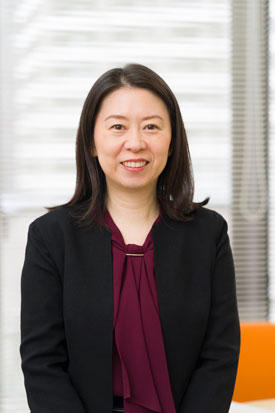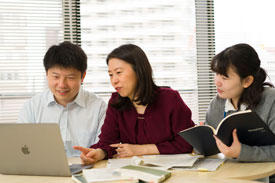

12/25/2018

AIMResearch talks to Ayumi Hirano-Iwata, a leading researcher at the Advanced Institute for Materials Research (AIMR) at Tohoku University. Her research straddles many fields, including bioelectronics and nanobiotechnology; she has also recently started collaborating with mathematicians. Hirano-Iwata joined Tohoku University in 2006, and in 2016 she became a principal investigator at the AIMR, which encourages researchers like her who want to overcome the boundaries between research fields by adopting an interdisciplinary approach.
AIMResearch: It is not easy pursuing a career as female researcher in Japan. What led you to become a scientist?
Hirano-Iwata: I remember being inspired after reading a book about Marie Curie when I was a middle school student. I struggled a bit when I started doing research as a university student as there were many things I didn’t know. But after clearing that initial hurdle, I started to really enjoy generating my own conjectures — and the feeling of gratification when they turned out to be correct. It was hard to find research jobs after graduating. At first, I was just doing analytical chemistry and finding it a bit narrow and restrictive. I wanted to get into technologies that are more physics based. It was then that I joined Tohoku University, where I started doing research involving microfabrication and pharma-materials. And that research really took off.
AIMResearch: What has been one of your career highlights?
Hirano-Iwata: I’ve been working on developing artificial cell-membrane sensors that mimic actual heart cell membranes with a view to using them to detect potential side effects of drugs on the heart. Our artificial cell membranes were initially very fragile, making them almost impossible to use as sensors. So we tried stabilizing them using microfabrication techniques, and it worked very well. That was certainly one highlight.
We’re continuing to work on them. Since drug side effects vary from person to person, we’d like to extend this approach for personalized medicine. If we can use microfabrication techniques to develop side-effect sensors tailored for individual patients, it will demonstrate the potential of using microfabrication for personalized medicine.
AIMResearch: What other projects are you working on?
Hirano-Iwata: I’m also leading a project in which we make circuits by taking neurons from rat brains and arranging them on small glass chips. These circuits are like miniature brains and they have functions that are beginning to resemble those of actual brains. In some cases, the circuits consist of just a few neurons, whereas in other cases we use about 100.
AIMResearch: Your research is interdisciplinary. What fields does it cover?
Hirano-Iwata: My research involves microfabrication, biomaterials, chemistry, electronic engineering, neuroscience and physiology. And I’m just starting a collaboration with mathematicians at the AIMR, including Hiroshi Suito, the leader of the Mathematical Science Group.
AIMResearch: Have you encountered any challenges in doing interdisciplinary research?
Hirano-Iwata: Initially, it was difficult to communicate with each other. But sometimes even miscommunication can advance research. For example, when we were making the artificial cell membranes, the researchers responsible for fabricating microapertures didn’t fully understand the biological aspects of the membranes. As a result, they made small tapered apertures. This ‘mistake’ turned out to be very effective in stabilizing the membranes. It was truly serendipitous.

AIMResearch: How does the AIMR encourage interdisciplinary research?
Hirano-Iwata: There are many research meetings that bring together scientists from different fields. For example, before joining the AIMR, I’d never been to a symposium by a mathematician. While working on fabricating artificial cell membranes at the AIMR, I was wrestling with how to figure out the best structure for our microfabricated chips to enhance the stability of the membranes, and I was beginning to despair that I’d ever be able to do it. But then I heard a presentation by a mathematician at an international symposium organized by the AIMR and I thought: “This person could solve the problem.” So I spoke to him after the presentation, and he was very enthusiastic about collaborating with me. I’ve found that mathematicians at the AIMR are all eager to help, which is a real boon to researchers such as myself who are working on materials and devices. It really makes it easy to collaborate. Other AIMR researchers, such as junior principal investigator Hiroshi Yabu, are also working on the collaborative project to fuse biomaterials with mathematics.
AIMResearch: What kind of collaborations do you have beyond Tohoku University?
Hirano-Iwata: I’m collaborating with a microfabrication scientist at Yamagata University and a protein researcher at Saitama University. A scientist at Toyohashi University of Technology is helping us characterize the artificial cell membranes. Overseas collaborations include one with Jordi Soriano at Barcelona University. He’s an expert in the nervous system and is very good at analyzing the complex data generated by the neural circuits we make. Also, Tay Netoff of the University of Minnesota in the US is a specialist in small neural networks and we’re working with him in constructing artificial networks of neurons.
AIMResearch: As a female researcher, how do you find the research environment at the AIMR and Tohoku University?
Hirano-Iwata: The situation has changed considerably since I was a student. I was lucky to become a PhD student as some professors wouldn’t take women as PhD candidates. But the environment has changed to the point that sometimes being female can almost be advantageous. Tohoku University was the first university in Japan to admit female students, and it has developed a system for supporting female researchers and nurturing female leaders throughout the university.
AIMResearch: Did you have any role models?
Hirano-Iwata: Of course, Marie Curie was a big inspiration. In Japan, there was also Maki Kawai, who went to the same university as me. She has gone on to become a top researcher. She developed spatially selective single-molecule spectroscopy, and, in 2018, she became the first woman to become president of the Chemical Society of Japan. I aspire to be like her. Kaoru Tamada at Kyushu University who is a well-regarded professor was another good role model for me. Closer to home, there is Motoko Kotani, who leads the AIMR. It’s a big encouragement having a female director at the institute who is also a top mathematician. She does a great job of leading the AIMR, while making efforts to create a research environment that is attractive for women, in keeping with Tohoku University’s strong tradition of promoting female involvement in science.